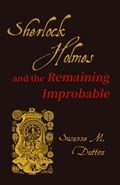From his rural cottage, Holmes no longer provokes Scotland Yard’s envy or his landlady’s impatience, but neither is he content with the study of bees. August 1920 finds him filling out entry papers at a nearly defunct psychiatric clinic on the Normandy coast. England has declared his cocaine use illegal and he aims to quit entirely. Confronted by a question as to his treatment goal, Holmes hesitates, aware that his real goal far exceeds the capacity of any clinic. His scribbled response, “no more solutions, but one true resolution” seems more a vow than a goal to his psychiatrist, Pierre Joubert. The doctor is right. Like a tiny explosion unaccountably shifting a far-reaching landscape, the simple words churn desperate action and interlocking mystery into the lives of Holmes’ friends and enemies both.
Through the doctor's notes, the reader follows the treatment of his famous patient. In his first session, Holmes recounts his earliest drug experiences, the coca leaf tea applied to his teething pains and the popular Godfrey’s Cordial and Mrs. Winslow’s Child Preservative, containing opium and morphine. He admits that on entering Christ Church College, Oxford, his access to cocaine widened as his reliance deepened. As he once famously asserted to Watson, the drug lifted him out of the intolerable “stagnating routines” of life. He can’t recall when the lines blurred, when life itself became the thing from which he craved lifting.
Though Joubert has long admired the famous detective, Holmes proves an irascible patient. He diagnoses his doctor’s ailments and denies his professional assumptions. He demands quieter rooms, claims that clinic meals cramp him, and rejects group therapy outright.
His doctor is satisfied, however. Signs are good. It’s all part of a normal, necessary adjustment. Holmes walks in the countryside—albeit after dark—and a fierce game of singles tennis seems to break the awful tedium that gnaws at him. Hypnosis fascinates Holmes as well, until in one trance he regresses beyond vivid boyhood memories of his father’s French art collection to an ancestor’s disturbing experience in the French Revolution. Joubert adamantly counsels that these images are not history, only unique creations of the psyche.
Five weeks into his treatment, the detective’s eyesight weakens. His weight drops. A wheeled chair and an orderly prove necessary. Sleep eludes him, replaced by ominous hallucinations. Then his personal belongings go missing and reappear, strangely altered. Two of these tricks strike Holmes as childish. The last is different, though not the usual threat of violence. This is deeply personal, darker and even more troubling. Has he such an enemy in the sanatorium? In spite of his determination to overcome his addiction, he knows he is vulnerable as never before. Must he leave? Surely not, at least not without the clarifying facts he needs to form a deduction.
Not long afterward, John Watson opens a late afternoon telegram originating in Eastbourne and directed to his London surgery: Most deeply cherished friend John. The game is afoot. Please take the Brighton Line from Victoria to Eastbourne at ten in the morning. Revolver unnecessary. Sherlock Holmes
The message gratifies Watson. Obviously, Holmes has completed his treatment in Normandy and misses their old life together as much as he. Happily, he anticipates another case and looks forward to being not just Dr Watson, but “Watson, Confederate and Chronicler.” A hurried leave of absence is not impossible, he reasons. He has already reduced his office hours and watched as his patients cooperate to an unflattering extent, transferring their loyalties to his younger partner.
So it happens that Watson, after a number of years, entrains once more for Eastbourne and finds himself caught up in the most unique and outrageous Holmes adventure no one will ever hear about.

